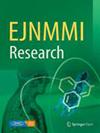Neuroimaging-guided diagnosis of possible FTLD-FUS pathology: a case report
IF 3.1
3区 医学
Q1 RADIOLOGY, NUCLEAR MEDICINE & MEDICAL IMAGING
引用次数: 0
Abstract
This case report presents a patient with progressive memory loss and choreiform movements. Neuropsychological tests indicated multi-domain amnestic mild cognitive impairment (aMCI), and neurological examination revealed asymmetrical involuntary hyperkinetic movements. Imaging studies showed severe left-sided atrophy and hypometabolism in the left frontal and temporoparietal cortex. [18F]Flortaucipir PET exhibited moderately increased tracer uptake in hypometabolic areas. The diagnosis initially considered Alzheimer’s disease (AD), frontotemporal degeneration (FTD), and corticobasal degeneration (CBD), cerebral hemiatrophy syndrome, but imaging and cerebrospinal fluid analysis excluded AD and suggested fused-in-sarcoma-associated FTD (FTLD-FUS), a subtype of the behavioural variant of FTD. Our case highlights that despite the lack of specific FUS biomarkers the combination of clinical features and neuroimaging biomarkers can guide choosing the most likely differential diagnosis in a complex neurological case. Imaging in particular allowed an accurate measure of the topography and severity of neurodegeneration and the exclusion of AD-related pathology.神经影像引导下的 FTLD-FUS 病理诊断:病例报告
本病例报告介绍了一名渐进性失忆和舞蹈状运动的患者。神经心理测试表明患者存在多域失忆性轻度认知障碍(aMCI),神经系统检查显示患者存在不对称的不自主过度运动。影像学检查显示,患者左侧额叶和颞顶叶皮层严重萎缩,代谢低下。[18F]Flortaucipir PET显示,代谢低下区域的示踪剂摄取量中度增加。诊断最初考虑为阿尔茨海默病(AD)、额颞变性(FTD)和皮质基底变性(CBD)、脑半萎缩综合征,但影像学和脑脊液分析排除了AD,并提示融合肉瘤相关FTD(FTLD-FUS),这是FTD行为变异的一种亚型。我们的病例突出表明,尽管缺乏特异性 FUS 生物标志物,但临床特征和神经影像学生物标志物的结合可以指导在复杂的神经系统病例中选择最可能的鉴别诊断。尤其是影像学检查可以准确测量神经变性的地形和严重程度,并排除 AD 相关病理。
本文章由计算机程序翻译,如有差异,请以英文原文为准。
求助全文
约1分钟内获得全文
求助全文
来源期刊

EJNMMI Research
RADIOLOGY, NUCLEAR MEDICINE & MEDICAL IMAGING&nb-
CiteScore
5.90
自引率
3.10%
发文量
72
审稿时长
13 weeks
期刊介绍:
EJNMMI Research publishes new basic, translational and clinical research in the field of nuclear medicine and molecular imaging. Regular features include original research articles, rapid communication of preliminary data on innovative research, interesting case reports, editorials, and letters to the editor. Educational articles on basic sciences, fundamental aspects and controversy related to pre-clinical and clinical research or ethical aspects of research are also welcome. Timely reviews provide updates on current applications, issues in imaging research and translational aspects of nuclear medicine and molecular imaging technologies.
The main emphasis is placed on the development of targeted imaging with radiopharmaceuticals within the broader context of molecular probes to enhance understanding and characterisation of the complex biological processes underlying disease and to develop, test and guide new treatment modalities, including radionuclide therapy.
 求助内容:
求助内容: 应助结果提醒方式:
应助结果提醒方式:


